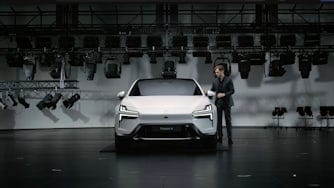The mule trike in motion: a Re:Move project update
When the rubber hits the road. An expression that refers to the moment when theory becomes reality, when an idea is tested in the real world for the first time. And what happened, figuratively and literally, when the Re:Move mule trike had its first test.
It was hugely rewarding to be able to feel the scale of Re:Move in real life for the first time.
A collaboration between Polestar, Konstantin Grcic (who first conceived of the vehicle), Wallpaper*, Hydro, and CAKE, Re:Move is designed to encourage discussion around what forms electric mobility will take.
Given that it’s narrow enough to traverse bike lanes, while being strong enough to carry substantial cargo, Re:Move isn’t just made for last-mile deliveries in crowded urban centres. Rural areas lacking developed infrastructure can also be ideal environments for Re:Move’s brand of hardy, zero-emissions transport. It’s an answer to any number of questions that will come up as the electric mobility revolution converts people the world over.
And with this much riding on it (we do love to mix the literal and the figurative around here), it needs to be subjected to the same vigorous testing as any Polestar vehicle.
After months of design and engineering work, the team had assembled the mule, a testing vehicle featuring prototype components. The literal rubber hits the road moment had arrived. After all, Re:Move looks great on paper. It looks great as a 3D CAD model.
And it looks great in motion.












01/06
“We’re delighted with the first running of the unpowered mule,” says Polestar Director of Design Engineering Chris Staunton. “We learned a lot when it came to the feel of the trike, immediately identifying potential improvements we can make to the dynamics.”
“Having never created a vehicle like this before and having only analysed the suspension hardpoints in the virtual world, it was important to see if we’d come up with something intuitive to ride,” states Senior Design Engineer Michael Gricks. “After a week or so, it became the vehicle we were after. We were able to weave in and out, tilt the vehicle at speed and feel safe and in control.”
This first test run was a watershed. And as such, it confounded a few expectations, despite the countless hours of preparation. “Seeing it on its wheels and moving wasn’t all that surprising, as I’ve played through this scenario in my mind so many times,” says Re:Move designer Grcic. “The big difference was the silence. The mule has no engine of course, but even the finished vehicle will make no sound! I’d always imagined Re:Move performing like a surfboard. The fact that it will move silently makes this analogy even more true.”
Staunton and his team will continue to evaluate, tweak, and improve the mule over the next few weeks in preparation for the assembly of the actual Re:Move trike.
“We hope Konstantin will be able to join us to experience the tests for himself,” continues Staunton. “It was hugely rewarding to be able to feel the scale of Re:Move in real life for the first time.”
Which makes sense. No matter how painstakingly designed, how carefully rendered, Re:Move is a vehicle. A conveyance. It can’t be considered a success until it’s put in motion.
Until the rubber meets the road.


